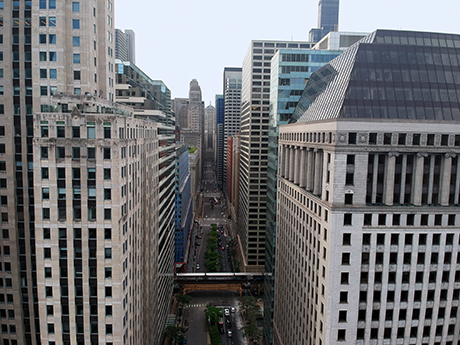Often dubbed the Wall Street of Chicago, the LaSalle Street corridor historically has been the location of choice for big business in the Windy City. However, in recent years the corridor has suffered from significant vacancies largely due to the remote work trend of the pandemic and an overall shift to remain remote permanently. In response, Chicago’s employers either downsized office space or completely left the office environment altogether.
Chicago’s overall office vacancy situation has been on an increasing trend for over two years. According to fourth-quarter 2022 data from brokerage firm Newmark, the vacancy rate for Chicago’s downtown office market increased 40 basis points from the previous quarter to 22.2 percent, and net absorption was negative for the 10th consecutive quarter.
When it comes to LaSalle St., vacancy rates for both office and retail on and near the corridor were higher than any other part of downtown as of mid-2022, according to market reports by the city. This shift in the market dynamics has led to millions of square feet of underutilized office space, empty streets and a historical area of the city badly in need of revitalization.
Against the backdrop, Chicago Mayor Lori Lightfoot in September 2022 introduced the LaSalle Street Reimagined Initiative, which aims to tackle the city’s affordable housing crisis and revitalize the once-bustling corridor.
“There is nearly 5 million square feet of vacant commercial space on the LaSalle Street corridor, but not a single unit of affordable housing,” says Mayor Lightfoot during a press conference announcing the project. “Diversifying this corridor is an essential component in our strategy to restore LaSalle’s vitality, create more neighborhood-serving retail, and foster a more inviting pedestrian environment in the heart of the Loop that will benefit all Chicagoans.”
Focused primarily on creating affordable housing opportunities, the initiative will provide $196 million in financial incentives for office-to-residential conversions within a designated area. LaSalle Central Tax Increment Financing (TIF) District will provide the funding. One of the program’s requirements is that a minimum of 30 percent of all proposed units for a project be designated as affordable.
The area targeted for projects encapsulates the city’s financial district, starting at the northern boundary of W. Washington Street and stretching southward to W. Van Buren Street with N. Wells Street making up the western boundary, stretching eastward to N. Clark Street.
The initiative is proving popular with both developers and investors. Proposals were due Dec. 23, 2022. At its inception, founders of the program aimed to build approximately 1,000 new homes that included 300 units of affordable housing. As of January 2023, a total of seven buildings and nine proposals showed investment potential of $1.2 billion and slightly more than 2,000 units, according to Chicago’s Urbanize website.
In addition to housing, neighborhood-oriented businesses such as restaurants and cafes will also be offered financial incentives to open in the LaSalle Street corridor thanks to a $5 million grant program approved by the city council. The city’s Small Business Improvement Fund (SBIF) program will provide grants of up to $250,000 for projects that create pedestrian-friendly, street-level storefronts.
“LaSalle’s future as a healthy, mixed-use business center depends on amenities being available for workers and residents — places where people can shop, eat, relax and enjoy the experience of being at the heart of the Loop,” says Maurice Cox, department of planning and development commissioner in prepared remarks.“This program will help building owners and retailers to achieve that goal on behalf of the entire city.”
— By Kari Lloyd, editor of Midwest Multifamily & Affordable Housing Business magazine


